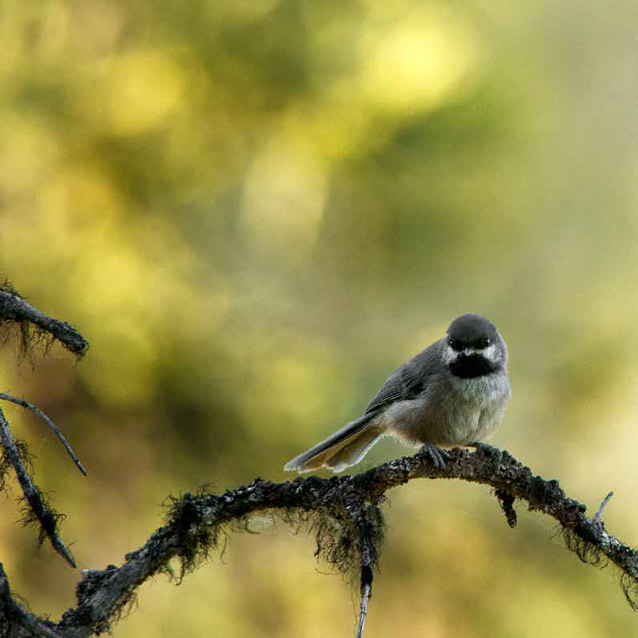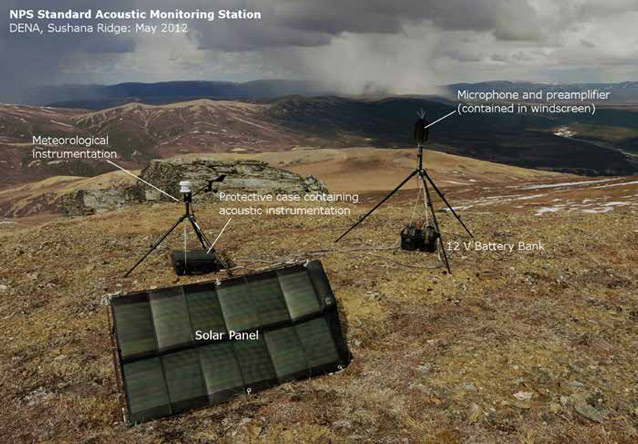Take a moment to imagine a misty June morning in Denali National Park. Now place yourself within the aural context: From all around you comes the spiraling song of Swainson’s thrush, the mirror-image retorts of contested white-crowned sparrows, and the bell-like ringing of a dark-eyed junco. These, and the vocalizations of other species too distant to identify, combine to form the ambience of an open spruce woodland habitat.

A boreal chickadee
It may surprise you to find the National Park Service recognizes and protects these songs as part of the entirety of the natural acoustic environment. Direction for management of the natural acoustic environment is represented in 2006 Management Policy 4.9: “The Service will restore to the natural condition wherever possible those park soundscapes that have become degraded by unnatural sounds (noise), and will protect natural soundscapes from unacceptable impacts” (NPS 2006a).
The initial push for Denali to inventory the acoustic environment was Director’s Order 47 (DO-47; NPS 2000). Robert Stanton issued the order in 2000, stating that “natural sounds are intrinsic elements of the environment that are often associated with parks and park purposes…They are inherent components of ‘the scenery and the natural and historic objects and the wild life’ protected by the NPS Organic Act.” DO-47 directed park managers to “(1) measure baseline acoustic conditions, (2) determine which existing or proposed human-made sounds are consistent with park purposes, (3) set acoustic management goals and objectives based on those purposes, and (4) determine which noise sources are impacting the park and need to be addressed by management.” Furthermore, it requires park managers to “(1) evaluate and address self-generated noise, and (2) constructively engage with those responsible for other noise sources that impact parks to explore what can be done to better protect parks” (NPS 2000).

NPS Photo
Since 2000, the Natural Sounds and Night Skies Division of the National Park Service has sought to improve the ability of parks to comply with these directions. Developing a method to collect relevant information on the acoustic environment was the first challenge. In the absence of readily-available commercial products for acoustic monitoring, the NPS has led the way for land management agencies by developing an autonomous system that can provide both American National Standards Institute (ANSI) certified acoustic levels (i.e., numeric measurements of sound pressure level in decibel units,) and audio recordings (i.e., sound that one can listen back to in headphones.) ANSI also recommends the collection of meteorological data concurrent with measurements of sound pressure level. Thus, a simple weather station incorporating wind speed, wind direction, temperature, and relative humidity is also part of the acoustic monitoring station. Figure 2 shows an external photograph of a typical station. A simplified schematic of the internal signal routing is presented in Figure 3.
Since 2006, Denali has been using such automated acoustic equipment to conduct a spatially balanced inventory of the park’s acoustic environment on a grid at the 6.2 x 6.2 mile scale (10 x 10 kilometers.) The effort is part of the Central Alaska Network long-term monitoring program. At present, staff members have collected data at 85 unique sites, making the dataset the most expansive in the nation. Detailed descriptions of the soundscape at each of these sites can be found in annual Denali soundscape monitoring reports (Withers and Hults 2006; Withers 2010; Withers 2011; Withers 2012; Withers and Betchkal 2013; Betchkal 2013a; and Betchkal 2013b). We can infer much about Denali’s natural acoustic environment from such data. It is especially enticing to apply these data to the study of soundscape ecology, a field that has advanced rapidly in the last few decades. Soundscape ecology is the interface

NPS Image
As such, it is concerned with the total assemblages of sound across a range of spatial and temporal scales. Contrast this with the role that sound recording has played historically in the study of bioacoustics: short clips documenting specific instances of communication or behavior in one or a few species.
Though assemblages of short recordings or species-specific studies are valuable scientific information, the recent transition in scope reflects the increasing ability of sound recording devices to address previously unapproachable community scale questions.
One thing is clear, at least. Since their inception in 1877, sound recording devices have become steadily more reliable as instruments of field science. More than ever, they are compact and resistant to the elements. They reproduce signals with greater fidelity. Their demand for power has dropped precipitously, while at the same time their memory capacity has expanded. Improved computation and file transfer speed has contributed to the feasibility of working with and archiving large audio recordings.
Ecologists have responded to these advances by rigorously testing the application of such systems. As early as 1957, ornithologists were using sound recording devices to estimate the density of nocturnally migrating songbirds (Graber and Cochran 1959). However, such early examples of audio-based avian ecology techniques are somewhat rare. It was not until the digital era of the 1990s that the scientific community began to fully realize audio recorders as tools. For instance, researchers recognized that audio recordings offer a permanent record that could be valuable in situations where many vocalizations overlap, allowing an analyst to listen to the same sound repeatedly in an effort to increase accuracy (Haselmayer and Quinn 2000). Other researchers saw the objectivity of microphones and the ability to archive audio data among the benefits of the technique (Hobson et al. 2002). The National Park Service itself has studied the effectiveness of acoustic monitoring equipment to supplement traditional avian point counts for over a decade (Daw and Ambrose 2003).
Part of a series of articles titled Alaska Park Science - Volume 14 Issue 2: Birds of Alaska's National Parks.
Last updated: July 17, 2018






